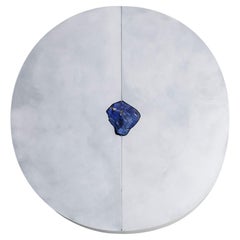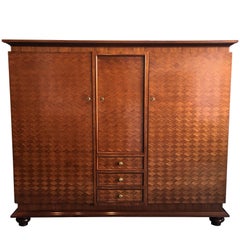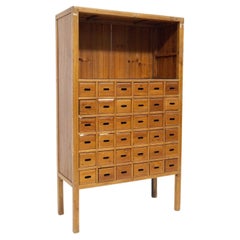Lapis Lazuli Wardrobes and Armoires
to
Height
to
Width
to
Depth
to
1
1
1
315
1,764
714
378
360
1
1
Material: Lapis Lazuli
Auminium Round Wall Cabinet with Deep Blue Natural Stone by Pierre De Valck
Located in Geneve, CH
Round wall cabinet with lapis lazuli by Pierre De Valck.
Dimensions: W 90 x D 15 x H 90 cm.
Materials: Waxed aluminium with Lapis Lazuli.
Weight: 45...
Category
2010s Belgian Post-Modern Lapis Lazuli Wardrobes and Armoires
Materials
Lapis Lazuli, Aluminum
Related Items
French parquetry Cabinet Armoire by Jules Leleu
By Jules Leleu
Located in Atlanta, GA
A large cabinet with parquetry design by Jules Leleu Paris, Model no. 4178. Designed in 1951 and this example is dated to 1953. Functioning as an Armoire for wardrobe, the cabinet fe...
Category
1950s French Mid-Century Modern Vintage Lapis Lazuli Wardrobes and Armoires
Materials
Bronze
Italian Wooden Storage Cabinet with Drawers
Located in Milano, IT
Italian storage cabinet from the early 1900s. The cabinet is made of larch wood, excellent workmanship and processing and technique of wood. The cabine...
Category
Early 1900s Italian Industrial Antique Lapis Lazuli Wardrobes and Armoires
Materials
Wood
Important Renaissance Cabinet from Lyon 'France' with a Decor of Perspectives
Located in Saint-Ouen, FR
As soon as 1540 France's second Renaissance is in the making, intimately linked to the rediscovery of the Antique world. The development of the printing and engraving industry allows the spread of artworks and models in many cities and countries. The Italian influence can be perceived in every artistic field. While the French king entrust the most talented Italian artists with major projects such as Il Rosso or Primaticcio in Fontainebleau, French artists also travel to Italy to form themselves to this new style. In Italy they get acquainted with the work of Leo Battista Alberti the first to theorize perspective (De Pictura, 1435-36) and architecture (De re oedificatoria, 1541). Those two publications would have a revolutionary impact on arts.
Furniture is marked by the work of the most famous Italian architects of the time as well as French architects. Indeed Philibert de l'Orme competes with Alberti and by the end of his life publishes several treaties including one devoted to a theory of architecture (1567). Unfortunately he would not live to complete the second volume. In this treaty he expresses his interest for mathematical norms applied to architecture, copied from the Antique. His journeys in Italy allowed him to accumulate the most sophisticated references. Jean Bullant, another architect of great talent also theorizes his practice. He establishes rules characterizing Greco-Roman art staying faithful to Vitruvius.
Following this new inspiration the structure of furniture evolves. From then on appear columns, capitals, cornices, friezes and architraves. The ornamentation uses this inspiration as well with egg-and-dart, palm leaf and rose adorning the most beautiful pieces.
In Lyon, crossroad where meet merchants from everywhere those new experiments are welcomed. Lyon florishing printing industry allows the spreading of models and treaties essential to the artist's work. Thus the first publication of Vitruvius' De Architectura in France would be printed in Lyon in 1532.
Artists from Lyon rediscover and familiarize themselves with the Antique knowledge very early. They adopt those new ideas and use them in their own creations. Lyon cabinet-makers re interpret Antique architecture and Italian Renaissance palaces to give their pieces a pure and harmonious architectural structure. Grooved pilasters are particularly favored. They are topped by capitals of diverse orders always respecting the sequencing with simpler ones for the lower levels and the richest ones on the higher levels. As for the ornamentation, one of the great distinctiveness of Lyon workshops remains the architectural perspective illusions, drawing inspiration from Tuscany.
True masterpiece of the Second French Renaissance this important cabinet illustrates Lyon workshops' taste for fine Italian architecture inspired by Antiquity. An architectural perspective of great quality is treated in symmetry on each panel.
This two-bodied cabinet without recess stands on four rectangular feet. The base comprises a molding, a palm leaf frieze and is bordered by a braid.
The lower body is divided by three grooved pilasters with Tuscan capitals framing two door-leaves. The two panels are encircled by a moudled frame with palm leaves. They are finely carved with a decor of fantasized architecture depicting an Italian Renaissance palace erected symmetrically on each side of a grooved pilaster. On the ground floor a door opens through a stilted arch while the stories are opened with mullioned windows, dormers and occuli. Two large pegged-boss cladded pillars support the entablature enriched by a palm leaf frieze upon which stands an arch whose coffered intrados is centred by a rose. Behind this arch a pyramid appears, standing in front of a second facade with a window topped by a broken curvilinear pediment under a cul-de-four with a shell.
The checker flooring gives depth to the low-reliefs creating vanishing points structuring the panels and guiding the eye of the observer.
A thin laurel braid highlights the belt of the cabinet where are located two drawers. Their facades are adorned by palm leaves in hoops.
The upper body is encircled with palm leaves. The same ternary division as in the lower body appears. However, the pilasters are topped by Ionic capitals with volutes and egg-and-dart. The door-leaves are framed with flowers. On the panels the artist has designed another architectural decor. On the foreground open two arches on top of grooved pilasters with rectangular capitals adorned with palm leaves. The arches are enriched with braids and the coffered intrados bears a decor of roses. The spandrels also bear a flower decor. In the background another arcature hosts a fluted grooved column topped with double basket acanthus capital, characteristic of Corinthian order. The triangular pediment is interrupted by a choux bourguignon.
A large cornice crowns the cabinet. It stands on pilasters and forms an entablature comprising a palm leaf frieze and an egg-and-dart, triglyph and palm leaf cornice.
The cabinet's sides have also been carefully considered. The lower body's panels are enriched with an arch rising above a broken pediment portico hosting a twisted column. Flowers garnish the spandrels. An architectural facade completes the decor. The upper body's panels present two arches supported by a facade opened with dormers and mullioned windows as well as cartouches (one bears the inscription 1580 dating the cabinet) suggesting the interior of an Italian Renaissance palace, confirmed by the chandeliers. The flooring leads our gaze to a second arch with a broken curvilinear pediment where stands a flower vase. This arch opens onto a perspective of another facade along a road.
Inside the cabinet, on the lower body door-leaves appear two designs. On the right door is depicted a Crucifixion. Saint Mary and Saint John flank the Christ on the cross. In the bottom part is inscribed « Dure uiator abis nihil haec spectacula curas / Pendenti cum sis unica cura Deo. / Tota suo moriente dolet natura Magistro. / Nil qui solus eras caussa dolenda doles. ». The signature [Christoff Swartz Monachiensis pinx[it] / Ioa[nnes] Sadeler sculp[it]] tells us it was made by Johan Sadeler I (1550-1600) after Christoph Schwartz (1548-1592). This engraving belongs to an ensemble depicting the Passion of Christ Johan Sadeler executed in 1589 after an altar piece painted by Christoph Schwartz for the private chapel of Renée of Loraine, wife of Duke William V of Bavaria. This altar piece made of nine copper panels has been destroyed during the 19th century. The Crucifixion panel once in the centre of the altar piece is the only one that survived and is today kept in Munich's Alte Pinakothek.
On the left door appears Saint Francis receiving the stigmata. The inscription says : « Signastidomine Servum Tuum. Franciscum. Signis Redemptionis Nostrae ».
This Renaissance cabinet with an architectural decor appearing as much in the structure faithful to Antique rules...
Category
16th Century European Renaissance Antique Lapis Lazuli Wardrobes and Armoires
Materials
Walnut
$177,326
H 87.41 in W 74.81 in D 27.17 in
Spanish Pinewood Kitchen Cupboard-Cabinet with Doors
Located in Marbella, ES
Spanish Pinewood Kitchen Cupboard-Cabinet with Doors
Category
Early 20th Century Spanish Lapis Lazuli Wardrobes and Armoires
Materials
Pine
Custom Oak Cabinet with Pocket Doors by Dos Gallos
Located in Los Angeles, CA
Custom oak cabinet with pocket doors and two large drawers. This cabinet is made to client's specifications and can be made in any size, conf...
Category
21st Century and Contemporary American Rustic Lapis Lazuli Wardrobes and Armoires
Materials
Oak
Modern Chelsea Glass Mosaic Bar Cabinet with Forged Metal Base by Ercole Home
By Ercole Home
Located in Brooklyn, NY
The Chelsea bar cabinet by Ercole Home has a 4-door front, with white lacquer wood finish on oak.
Hand cut glass mosaics in London grey and icy white decorate the surface in Luis pat...
Category
2010s American Modern Lapis Lazuli Wardrobes and Armoires
Materials
Metal
$18,500
H 84 in W 42 in D 16 in
COCO CABINET - Modern Ebony Oak Cabinet with Brass Inlays and Acrylic Handles
Located in Laguna Niguel, CA
COCO CABINET - Modern Ebony Oak Cabinet with Brass Inlays and Acrylic Handles
The Coco Cabinet is a luxurious piece of furniture that features an Art Dec...
Category
2010s American Modern Lapis Lazuli Wardrobes and Armoires
Materials
Oak
$28,480 / item
H 72 in W 46 in D 21 in
Pair of Monumental Post-Modern Obelisk Cabinets
Located in Palm Springs, CA
A truly unique pair of Post-Modernist cabinets in the form of a faux porphyry obelisk or pyramid on four gilded balls, resting on a black plinth base. Each cabinet contains four draw...
Category
20th Century American Post-Modern Lapis Lazuli Wardrobes and Armoires
Materials
Laminate, Wood
$7,200 Sale Price / set
37% Off
H 76.5 in W 32.75 in D 23.75 in
Cabinet with Hand Painted Tile
Located in Saint-Ouen, FR
Estimated production time: 15-16 weeks.
Heritage Cabinet is an elegant décor piece to compliment the decoration of any interior setting. A highly coveted ensemble of hand painted tiles...
Category
21st Century and Contemporary European Lapis Lazuli Wardrobes and Armoires
Materials
Brass, Gold Leaf
Cabinet
Located in Saint-Ouen, FR
Designed passionately and exquisitely by the incomparable talents, the Cabinet was created to grace the most regal of dining rooms with its elegance and splendor. Inspired by the aristocratic palaces of the Alexandrian pashas of Egypt, the mother of pearl Cabinet...
Category
21st Century and Contemporary European Lapis Lazuli Wardrobes and Armoires
Materials
Wood
16th Century Cabinet with Knights Carving from Avignon Workshops 'France'
Located in Saint-Ouen, FR
Collection Jean Thuile
Around the mid-sixteenth century French furnishing evolves in its conception and ornamentation. The start of major archi...
Category
16th Century French Renaissance Antique Lapis Lazuli Wardrobes and Armoires
Materials
Walnut
$29,554
H 87.41 in W 55.91 in D 21.86 in
Florentino Black Cabinet With Colourfully Painted Interior
By Brett Paulin
Located in Toronto, Ontario
Elevate your space with the luxurious Florentino Black Cabinet. Expertly crafted from premium figured maple, white oak, and walnut woods, this hand made armoire is a stunning piece o...
Category
2010s Canadian Bohemian Lapis Lazuli Wardrobes and Armoires
Materials
Birdseye Maple, Oak, Walnut
Previously Available Items
Round Wall Cabinet with Lapis Lazuli by Pierre De Valck
Located in Geneve, CH
Round wall cabinet with lapis lazuli by Pierre De Valck.
Dimensions: W 90 x D 15 x H 90 cm.
Materials: Waxed aluminium with Lapis Lazuli.
Weight:...
Category
2010s Belgian Post-Modern Lapis Lazuli Wardrobes and Armoires
Materials
Lapis Lazuli, Aluminum



